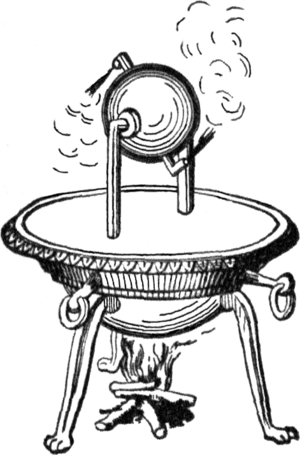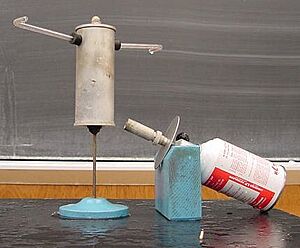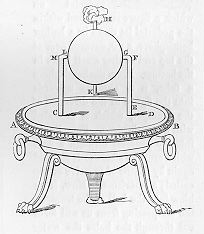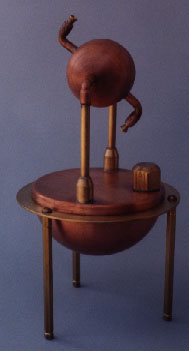Aeolipile facts for kids
An aeolipile (pronounced ee-OH-li-pile) is a simple steam engine. It's also called a Hero's engine. This device spins when a container of water inside it is heated. It works like a simple spinning machine that uses steam.
The aeolipile creates a turning force, called torque, from steam shooting out of small nozzles. A Greek-Egyptian mathematician and engineer named Hero of Alexandria described it around 1 AD. Many people think he invented it. However, another writer named Vitruvius actually wrote about it first, around 30-20 BC.
People often call the aeolipile the first recorded steam engine. But it wasn't used for practical work. It also wasn't a direct ancestor of the powerful steam engines from the Industrial Revolution.
The name "aeolipile" comes from Greek and Latin words. It means "the ball of Aeolus". Aeolus was the Greek god of air and wind.
Contents
How the Aeolipile Works
An aeolipile usually has a round or cylinder-shaped container. This container has nozzles that bend outwards in opposite directions. The whole thing is designed to spin on an axis.
When steam builds up inside the container, it shoots out of the nozzles. This creates a pushing force, like a rocket. This happens because of Newton's Third Law of Motion. For every action, there is an equal and opposite reaction.
Since the nozzles point in different directions, the forces they create make the container spin. This spinning continues until air resistance and friction slow it down. Eventually, it reaches a steady speed.
Usually, water is heated in a boiler. This boiler is often part of the stand that holds the spinning container. Pipes connect the boiler to the container. These pipes also act as the pivots that the container spins on. Sometimes, the spinning container itself can be the boiler. This makes the design simpler.
History of the Aeolipile
Both Hero and Vitruvius learned from earlier work. This work was done by Ctesibius. He was an inventor and mathematician in Alexandria, Egypt, around 285–222 BC. Ctesibius wrote the first books about using compressed air. He also wrote about how it works in pumps.
Vitruvius's Description
Vitruvius (who lived from about 80 BC to 15 BC) wrote about aeolipiles. He said:
Aeolipiles are hollow bronze containers. They have a small opening. You can fill them with water through this opening. When the water is heated over a fire, not much wind comes out at first. But as soon as the water starts to boil, a strong wind shoots out.
Hero's Description
Hero (who lived from about 10 AD to 70 AD) gave instructions on how to build an aeolipile. He wrote:
No. 50. The Steam-Engine.
Put a pot over a fire. A ball will spin on a pivot. A fire is lit under a pot, A B, containing water. It is covered by a lid C D. A bent tube E F G connects to this lid. The end of the tube fits into a hollow ball, H K. Opposite the end G, place a pivot, L M, resting on the lid C D. The ball should have two bent pipes. They connect to it on opposite sides and bend in opposite directions. As the pot gets hot, steam enters the ball through E F G. It then leaves through the bent tubes towards the lid. This makes the ball spin.
Was it Used for Anything Practical?
We don't know if the aeolipile was used for anything practical in ancient times. Some people think it was just a curiosity or a "party trick" for the ancient Greeks. Hero's drawing shows it as a standalone device. It was probably meant to be a "temple wonder," like many other inventions he described.
However, Vitruvius mentioned using the aeolipile to show how weather works. He described them as:
bronze aeolipiles, which clearly show that looking closely at human inventions often helps us understand the general rules of nature.
After explaining how to build the device, he concluded:
So, a simple experiment lets us find out the causes and effects of the big things happening in the sky and with the winds.
In 1543, a Spanish navy captain named Blasco de Garay supposedly showed an invention to Emperor Charles V. He claimed it could move large ships without wind. This machine had a copper boiler and spinning wheels on the sides of the ship. Some people think de Garay might have used Hero's aeolipile. He might have combined it with Roman boat technology. This would have been a practical use for the aeolipile. It would have shown that steam could power paddlewheels. However, Spanish officials denied this claim.
See also
- Catherine wheel (firework)
- Rocket engine
- Segner wheel
- Steam engine
- Steam locomotive
- Steam rocket
- Tip jet





